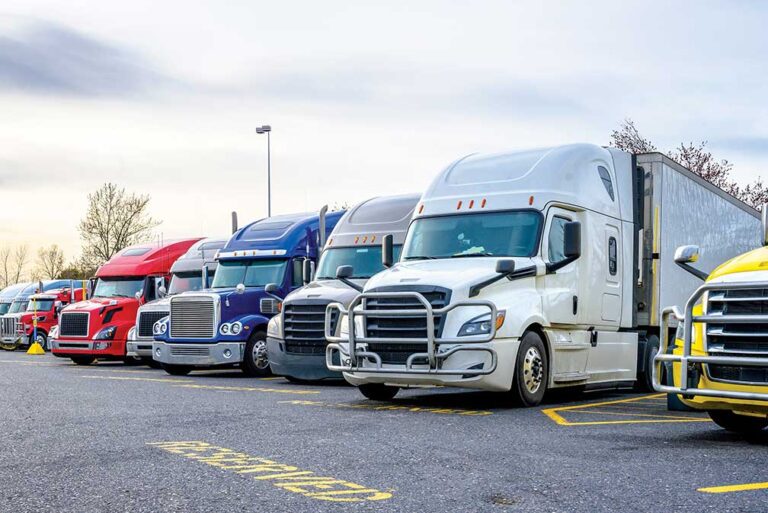A lack of adequate, safe truck parking hangs over the trucking industry like a dark, rain-soaked cloud that just won’t give way to sunny skies.
The issue has made its way to Washington many times over the years, but now federal legislation is finally beginning to move — albeit at a slow pace.
At the time of this writing in mid-December, Dave Heller, senior vice president of safety and government affairs for the Truckload Carriers Association, said he had been in and out of numerous meetings about the Truck Parking Safety Improvement Act (TPSIA).
“Our membership had tremendous success seeking co-sponsors during our Call on Washington event at the end of September. However, the bill itself still languishes, looking for a much larger piece of legislation to attach itself to,” he said.
Heller says he believes 2024 could be the year something is finally done to help.
“As the list of co-sponsors in the Senate continues to grow, the need for this legislation will only grow with it,” he said.
Meanwhile, he says, the trucking industry must continue to send this message to the nation: There simply are not enough parking spaces for big rigs.
“That is why it is paramount that we engage on this issue, citing the effects that limited safe and secure parking has on our fleet to our elected officials at every level of government,” he said.
Trucking industry headlines over the past year have included dozens of reports about new truck parking spaces, so it would seem at least some effort is being made to provide a solution.
Major truck stop chains have added hundreds of spaces, and several states have renovated areas specifically for truck parking.
For example, the Wyoming Department of Transportation (WYDOT) was awarded a federal grant from the U.S. Department of Transportation in late 2023 to build hundreds of new truck parking spaces in southwest Wyoming.
WYDOT will receive more than $26.6 million through the 2023-2024 federal Rural Surface Transportation Grant, which will be used to build about 365 truck parking spaces along Interstate 80 in Evanston.
The Arizona Department of Transportation (ADOT) has developed a statewide truck parking plan that recommends expanding parking at existing rest areas and adding three new facilities. ADOT’s plan is one of the more comprehensive solutions at the time of this writing.
After gathering feedback from the trucking industry, ADOT sought public input as transportation planners prepare to construct 842 truck parking spaces in 10 locations along interstates in areas with the greatest need for parking.
These locations are along Interstates 10, 40, and 8. In addition to expanded parking at existing rest areas, three proposed “safe lots” would provide parking for commercial trucks only.
ADOT recommends the additional parking be based on demand at existing rest areas and where undesignated truck parking occurs. Other factors include cost, ease of implementation, and input from the trucking industry.
Arizona’s sites prioritized for additional parking are:
- The I-10 Burnt Wells Rest Area near Tonopah: 103 spaces
- The I-40 Meteor Crater Rest Area near Winslow: 140 spaces
- A new I-10/State Route 186 safe lot just west of Willcox: 127 spaces
- I-40 Crazy Creek, a new safe lot about 35 miles east of Holbrook: 176 spaces
- I-10 Ehrenberg Rest Area: 53 spaces
- I-10 San Simon Rest Area: 80 spaces
- I-10 Bouse Wash Rest Area: 55 spaces
- I-40 Seligman, a new safe lot: 72 spaces
- I-10 Sacaton Rest Area: 20 spaces
- I-8 Mohawk Rest Area: 16 spaces
The plan recommends first adding parking to three critical locations — Burnt Wells, Meteor Crater, and a new safe lot near Willcox — based on the $32 million in funding currently available through the National Highway Freight Program. Parking at the additional seven locations could be added as ADOT seeks future funding. The additional parking would be in addition to current projects that are expanding parking at five rest areas, funded by the National Highway Freight Program.
While some states have begun to address the issue of closed or unusable rest/parking areas, there is still much work to be done.
In an effort to gain further data on the issue, Heller says TCA has started collecting information, allowing drivers to report closed rest areas that can be used for truck parking.
“Yes, they do exist,” he said of the closed rest areas. “Drivers have been reporting state, roads, and mile markers of those rest areas so we can highlight them in a manner that encourages the TPSIA to move more rapidly through the legislation process and make dedicated funding available that could be used to open these areas and provide more opportunities to locate safe and secure parking for our drivers that need it.”
This article originally appeared in the January/February 2024 edition of Truckload Authority, the official publication of the Truckload Carriers Association.
Born in Pine Bluff, Arkansas, and raised in East Texas, John Worthen returned to his home state to attend college in 1998 and decided to make his life in The Natural State. Worthen is a 20-year veteran of the journalism industry and has covered just about every topic there is. He has a passion for writing and telling stories. He has worked as a beat reporter and bureau chief for a statewide newspaper and as managing editor of a regional newspaper in Arkansas. Additionally, Worthen has been a prolific freelance journalist for two decades, and has been published in several travel magazines and on travel websites.















